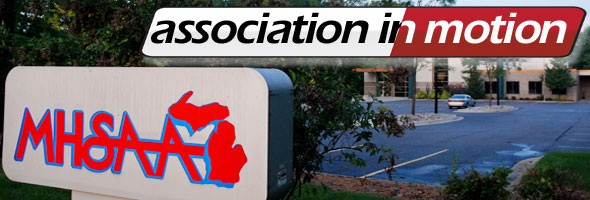
Pay-to-Play's Extent Unchanged in 15-16
July 21, 2016
By Geoff Kimmerly
Second Half editor
The percentage of Michigan High School Athletic Association high schools that assessed participation fees to help fund interscholastic athletics held steady at 51.5 percent in 2015-16 for the second straight school year after reaching a high of nearly 57 percent two years ago.
A total of 557 high schools – or 74 percent of the MHSAA membership – responded to the 2015-16 survey for a five percent increase from the year before and the highest feedback rate since 2010-11, when 74 percent of member high schools also responded. A total of 287 high schools, or 51.5 percent that took the survey, charged fees this school year, compared to the same percentage of 522 respondents in 2014-15.
There were 755 senior high schools in the MHSAA membership in 2015-16. This was the 12th survey of schools since the 2003-04 school year, when members reported fees were being charged by 24 percent of schools. The percentage of member schools charging fees crossed 50 percent in 2010-11 and reached 56.6 percent in 2013-14 before decreasing the following school year.
Class B schools continued to see a decline in fees in 2015-16, with 48 percent of respondents from that class assessing fees compared to 52 percent in 2014-15 and 62 percent of Class B schools in 2013-14. Class C and D saw minimal increases in the percentages of schools assessing fees this year, and for the second straight school year 70 percent of Class A respondents assessed fees.
Charging a standardized fee for each team on which a student-athlete participates – regardless of the number of teams – remains the most popular method among schools assessing fees, with that rate rising five percent to 44 percent total of schools that assessed fees in 2015-16. Schools charging a one-time standardized fee per student-athlete remained nearly constant, falling only from 28 to 27 percent over the last year. The survey showed a slight decrease in schools assessing fees based on tiers of the number of sports a student-athlete plays (for example, charging a larger fee for the first team and less for additional sports) and also a slight decrease in fees being assessed based on the specific sport being played.
The amounts of most fees also remained consistent from 2014-15 to 2015-16: the median annual maximum fee per student at $150, the median annual maximum family fee at $300 and the median per-team fee at $75. The median fee assessed by schools that charge student-athletes once per year did increase $20 to $120.
The survey for 2015-16 and surveys from previous years can be found on the MHSAA Website.
The MHSAA is a private, not-for-profit corporation of voluntary membership by more than 1,400 public and private senior high schools and junior high/middle schools which exists to develop common rules for athletic eligibility and competition. No government funds or tax dollars support the MHSAA, which was the first such association nationally to not accept membership dues or tournament entry fees from schools. Member schools which enforce these rules are permitted to participate in MHSAA tournaments, which attract more than 1.4 million spectators each year.

Council Discusses Transfer, 5th-Quarter Rules in Charting Future Work During Fall Meeting
By
Geoff Kimmerly
MHSAA.com senior editor
December 18, 2025
The Representative Council of the Michigan High School Athletic Association considered several reports concerning ongoing business relevant to its member schools, discussed topics surrounding the MHSAA’s transfer and 5th-quarter rules, and conducted its annual elections among other activities during its Fall Meeting on Dec. 5 in East Lansing.
Generally, the Council takes only a few actions during its Fall Meeting, with topics often introduced for additional consideration and action during its meetings in March and May. The Council took only one action at this meeting, to approve its annual audit, but discussed several topics that will be delved into further throughout the remainder of this school year.
A significant portion of Council discussion regarded the MHSAA transfer and 5th-quarter allowance rules. The transfer conversation focused primarily on students who play as part of non-MHSAA sports organizations during their first year or years of high school but wish to then play at a member high school. The Council also received an update on the Transfer Tracker tool under development that will provide schools greater guidance on eligibility determinations by monitoring when students change schools after ninth grade.
The 5th-quarter conversation considered how allowances made in recent years in basketball, football, soccer, lacrosse, baseball and field hockey have aligned with the intent of that allowance – to help schools save subvarsity teams from elimination because of low participation by allowing athletes to play on varsity and subvarsity teams simultaneously over a set number of periods each week.
The Council received updates on this fall’s inaugural MHSAA Field Hockey Tournament and also on the first boys volleyball season to be played during Spring 2026. MHSAA staff also informed the Council on a baseball rule proposal that would require a double first base, recent viewership of NFHS Network broadcasts, and MHSAA Sports Medicine Advisory Committee discussions especially concerning the statewide shortage of athletic trainers in schools. Additional updates were provided on MHSAA athletic director Update meeting and in-service programs and other administrative topics.
The Fall Meeting also saw elections of Council officers for the upcoming year. Brighton athletic director John Thompson was reelected president after completing the previous president’s term this summer and fall. Calumet teacher and past athletic director Sean Jacques was reelected as Council vice president after completing Thompson’s term, and Vic Michaels, director of physical education and athletics for the Archdiocese of Detroit, was reelected as secretary-treasurer.
Additionally, Wyoming Godfrey-Lee Schools superintendent Arnetta Thompson and Freeland Middle School principal Jennifer Thunberg were appointed for second two-year terms on the Council.
The Representative Council is the legislative body of the MHSAA. All but five members are elected by member schools. Four members are appointed by the Council to facilitate representation of females and minorities, and the 19th position is occupied by the Superintendent of Public Instruction or designee.
The MHSAA is a private, not-for-profit corporation of voluntary membership by more than 1,500 public and private senior high schools and junior high/middle schools which exists to develop common rules for athletic eligibility and competition. No government funds or tax dollars support the MHSAA, which was the first such association nationally to not accept membership dues or tournament entry fees from schools. Member schools which enforce these rules are permitted to participate in MHSAA tournaments, which attract more than 1.4 million spectators each year.

